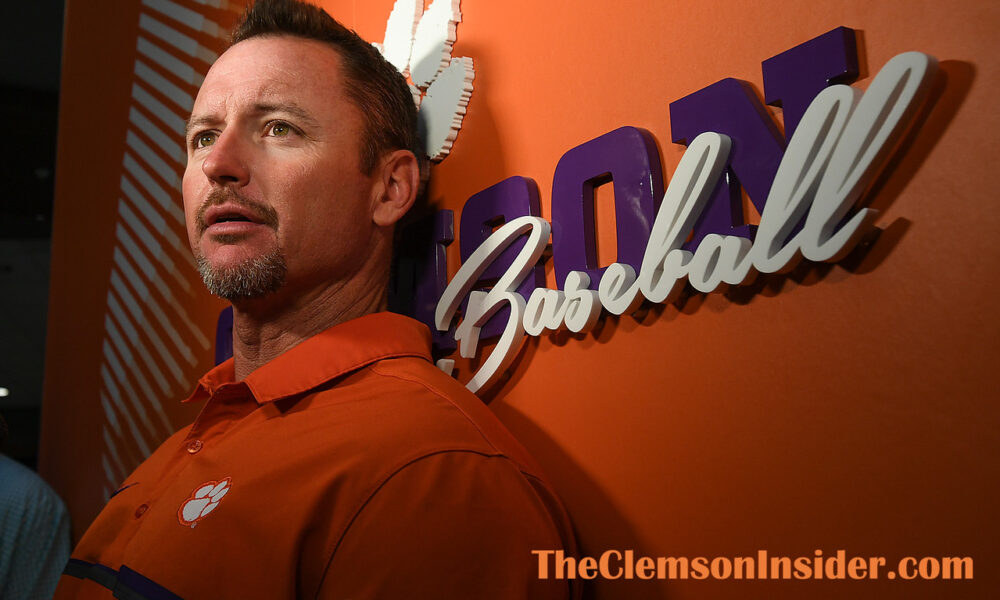The NCAA Division I Council voted this past Monday to allow schools to provide spring-sport student-athletes an additional season of competition and an extension of their period of eligibility due to losing a year of eligibility because of the COVID-19 pandemic.
The Council also increased the roster limit in baseball for student-athletes impacted by the COVID-19 pandemic, the only spring sport with such a limit.
“I think there are still a lot of questions to be answered,” Clemson baseball coach Monte Lee said to The Clemson Insider Tuesday. “We are still trying to digest what it means in terms of how it affects us in terms of roster relief, scholarship relief … how does eligibility for everybody work now? I am still trying to decipher through the information.”
So is Clemson’s compliance department which started going through all the information, new rules and regulations. When they are through, they will then get with Lee and his coaching staff and tell them how it all applies to baseball.
In a normal year, the NCAA allows 11.7 scholarships per team. Division I baseball team’s 11.7 scholarships can be divided between a maximum of 27 players on a 35-player roster, with all players on athletic scholarship having to receive a minimum of a 25 percent scholarship.
Division I rules limit student-athletes to four seasons of competition in a five-year period. The Council’s decision on Monday allows schools to self-apply waivers to restore one of those seasons of competition for student-athletes who had competed while eligible in the COVID-19-shortened 2020 spring season.
The Council also will allow schools to self-apply a one-year extension of eligibility for spring-sport student-athletes, effectively extending each student’s five-year “clock” by a year. This decision was especially important for student-athletes who had reached the end of their five-year clock in 2020 and saw their seasons end abruptly.
“There is a lot to be determined as far as how it is going to impact us. As you guys know, our sport is so different than everybody else,” Lee said. “Our guys don’t have to declare for the draft. We are going to have guys that are going to be drafted, but with the draft being shortened to five rounds, and they have said the draft can be expanded beyond five rounds, we don’t know what that looks like, yet. And pro guys don’t know either.
“If the draft is a five-round draft, that is going to restrict a lot of juniors that would have been drafted.”
For Clemson, it could mean guys like Kier Meredith, Spencer Strider, Mat Clark and a few others, guys who likely would have turned professional if they were drafted in a normal draft, will likely return, along with senior pitcher Carson Spiers.
“If they don’t have a draft past the fifth round, then there is going to be an influx of older players coming back into college baseball. But we don’t know yet,” Lee said. “How is it going to affect some of our juniors? I don’t even think they know quite yet if they are going to fall into that category and how do pro guys handle the draft? How are they still going to draft high school guys, or if you have five rounds of the draft are you going to take more proven college guys? Does that mean guys that might have been seventh-, eighth-, tenth-round picks, they get taken in the fourth or fifth rounds because they are going to go very college heavy. I don’t know.”
What Lee does know is that the MLB Draft is going to make an impact on every Power 5 roster like it never has before, good and bad.
“We will start to decipher it a little more over the course of the next week. Ultimately, how the draft plays into this is probably going to impact us more than anything,” Lee said. “I would think we stand a pretty good chance, and we don’t know, to potentially getting some guys back that would have been drafted for sure.”
Clemson fans now is the time to support the local businesses.
A great gift for any Tiger fan. Just one of many great items available from Clemson Variety & Frame

